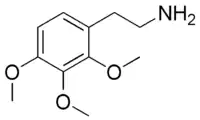Isomescaline
 | |
| Names | |
|---|---|
| Preferred IUPAC name
2-(2,3,4-Trimethoxyphenyl)ethan-1-amine | |
| Other names
2,3,4-Trimethoxyphenethylamine 2,3,4-Trimethoxy-1-ethaneamine | |
| Identifiers | |
CAS Number |
|
3D model (JSmol) |
|
| ChEMBL | |
| ChemSpider | |
PubChem CID |
|
| UNII | |
CompTox Dashboard (EPA) |
|
InChI
| |
SMILES
| |
| Properties | |
Chemical formula |
C11H17NO3 |
| Molar mass | 211.261 g·mol−1 |
Except where otherwise noted, data are given for materials in their standard state (at 25 °C [77 °F], 100 kPa). | |
| Infobox references | |
Isomescaline (2,3,4-trimethoxyphenethylamine) is a lesser-known compound based on a well-known psychedelic drug. It is an isomer of mescaline, as well as an analog of TIM-2, TIM-3, and TIM-4. Isomescaline was first synthesized by Alexander Shulgin. In his book PIHKAL, it is suggested that any potentially active dose would be "greater than 400 mg".[1] Despite its structural similarity to mescaline, isomescaline has produced no effects in humans. Very little data exists about the pharmacological properties, metabolism, and toxicity of isomescaline.
See also
References
This article is issued from Offline. The text is licensed under Creative Commons - Attribution - Sharealike. Additional terms may apply for the media files.